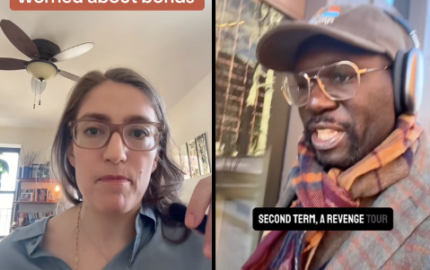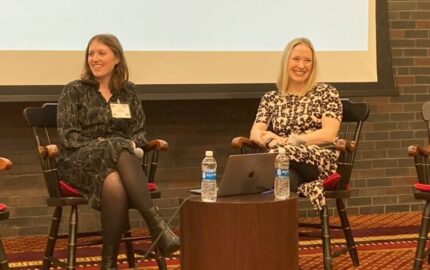 The discussion touched on “Mr. Plimpton’s Revenge,” created by veteran creative nonfiction writer Dinty W. Moore. Moore uses Google Maps to pinpoint the locations of a series of meetings with George Plimpton, including a short description for each encounter. The account straddles the line between being a series of funny anecdotes and a true narrative, with the visual component of the map creating a sense of time and distance between each encounter.
The discussion touched on “Mr. Plimpton’s Revenge,” created by veteran creative nonfiction writer Dinty W. Moore. Moore uses Google Maps to pinpoint the locations of a series of meetings with George Plimpton, including a short description for each encounter. The account straddles the line between being a series of funny anecdotes and a true narrative, with the visual component of the map creating a sense of time and distance between each encounter.Moore’s piece recalls “Hard Times” from The Washington Post’s Travis Fox, who crossed the country before the 2008 presidential elections to record how economic challenges were or weren’t affecting people’s political sensibilities. “Hard Times” uses also uses Google Maps and provides brief text at each mapped point, along with short, semi-narrative articles and video or still images. Fox, who is now teaching a Multimedia Storytelling class at Columbia University, made frequent use of interactive maps for many of his Post projects, including “Crisis in Darfur Expands” and “Mexico at War.” (At present, the latter doesn’t seem to be working quite right in Explorer or Chrome.)
Bookfuturists also mentioned David Nygren’s spreadsheet narrative “Under the Table.” Nygren’s short story breaks down each element in a traditional piece of fiction, organizing it into columns of action, spoken dialogue, and internal thoughts for each character. In a post on The Urban Elitist, Nygren explains his strategy and links to the story, which is available as an Excel or Google spreadsheet, or as a table in Word. One of Nygren’s readers has dubbed this version of storytelling “novexcel.”
The novexcel seems to be a cousin of the much-discussed charticle, but offers several layers of information at once. The story can be read left to right and down the page, as with traditional text narratives, but it can just as easily be scanned for just one element—a single character’s thoughts or the physical events that take place. This approach brings to mind Scott Carney’s “Cutthroat Capitalism” project for Wired, which we featured last fall. The Wired story spreads a bare-bones narrative arc across several tables and presents more elegantly in terms of design, but Nygren’s spreadsheet approach draws all the story elements into a single place for readers.
It may not yet be obvious how journalists can fully exploit the possibilities, but it's clear that a lot of interesting experiments are underway. For more on new media narratives, read our interview with Bookfuturist presenter Peggy Nelson, who takes elements from literary history and uses them to construct new stories on Twitter, Vimeo and lots of other places.


